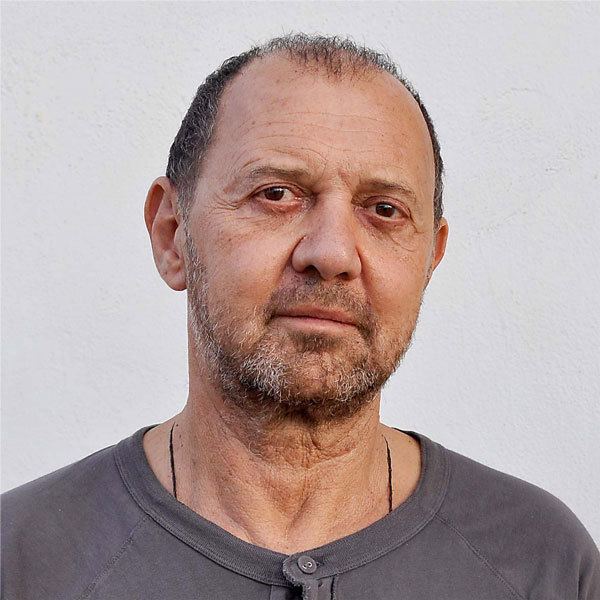Nationality israeli Name Enrique Rottenberg | Known for Photography | |
 | ||
Movement photography and installation | ||
Spring 2016 Inspiration | Enrique Rottenberg
Enrique Rottenberg (August 12, 1948) is an artist currently working with photography and installations. His artistic career is as plural as his national identity. Born in Argentina in 1948, to Jewish parents of Polish descent, he emigrated alone to Israel at the age of 13.
Contents
- Spring 2016 Inspiration Enrique Rottenberg
- IMG 0266
- Biography
- Photographic Work
- Statements of his series
- Exhibitions and Collections
- References
IMG 0266
Biography
After serving in the Israeli army, he developed a successful real estate business, while at the same time, beginning in 1980, he starts producing films and studies at the Camera Obscura School of Tel Aviv. Among his best known film sare: Nagua, Bar 51 and Himo the King of Jerusalem (by the filmmaker Amos Gutman), the film The Elected (with Daniel Waksman). He was the director and screenwriter of the film Revenge of Itzik Finkelstein, which won 7 awards from the Israeli Film Academy (including Best Film, Best Director and Best Screenplay) and represented Israel in 1994 for the Oscar.
In 1993, he arrived to Cuba where he currently lives. In Cuba, he built the Miramar Trade Center, a major business complex in the city of Havana, which he still runs to this day. In this center he also creates a significant Cuban art collection for the country.
He writes the novel Cejalinda, published under the title: La mujer de su vida, Quarto, Spain, in 2006.
In Cuba he began his photographic work. In 2010, his series Sleeping with… (Dormir con) is exhibited at the Cuban Photo Library (National Photography Museum), which now is part of the collection of this institution, and of numerous private and institutional collections along with other works of his. His first series Sleeping with... was exhibited in 2010 at the Photo Gallery of Cuba becoming part of the collection of this institution, and was chosen by Discoveries of PhotoEspana 2011. Today his work has wide recognition amongst the public and critics. He took part in the past Havana Biennial 2012, with two of his series, The Family and Self-portraits.
Among the most important series are: the Self-portraits (2011–2014), The Family (2011–2013), Forgotten (2013), Cuts (2013–2014) as well as large format works such as The Line (2014), Centipede (2014) and photo installations: 19 women and one bed (2012) and The dance (2014).
He collaborates with the new cultural project “Cuban Art Factory” (Fabrica de Arte Cubano), promoting the development of contemporary photography and visual arts in Cuba.
Photographic Work
The photographic work of Enrique Rottenberg may be considered controversial, satirical, manic-melancholic, lewd, empathic, alarming...The reasons behind the attraction that it causes, whether it be of allure or tension, laughter or pain, surprise or rejection, beauty and horror, are diverse, but they all seem to be gathered in a certain way under the Schelling's definition of the term: the disturbing oddness or the ominous (unheimlich): "(...) everything that being intended to remain a secret, hidden, has come to light."
But yet, everything that seems obvious and familiar becomes paradoxical and borderline absurd. Perhaps Rottenberg’s photography as an unsuspecting heir his film imagery, tries to represent timeless and motionless scenes, stunned characters, suspended environments, frozen stories, as if each and every one of them were shocked of suddenly coming to light, while remaining irremediably suspended. But this is the face-surface that is capable to opening towards another movement and another time, unknown, unusual, disjunct: the other scene – the fantasy, and the other scene of reality.
There is a movement that doesn’t stop within Rottenberg’s work, repeated and distressing, which builds its multiple layers, all the way from the greatly theatrical to the edge of reality, from the shadows of dreams to the brutal light of the vigil, from self-narcissism to mass psychology, to find the way out at any cost, reaching the encounter with what cannot be reconciled. In these provocations there’s a struggle, away of resisting. Resisting the orders and those who dictate, but also the dominated and defeated; the gods, the myths, the mimicry and consensus, but to some instance of resisting to destiny itself, to all the established and pre-established destinies, even that off innateness and the indecipherable meaning of life? Rottenberg is a manufacturer of history, because history is the necessity of life, in its differences with death.
He is also a destroyer of illusions. He has the ability to distress the subject, until he reveals some invisible, strange place within himself. The looks in his portraits are incisive, painful, powerful, and at the end of that open crack primary helplessness looms. In his composition she uses eloquent backgrounds, as if what is behind the scene were the undertone of his real meaning.
Rottenberg’s language of is paradoxical, whence that feeling of surprise and perplexity: on one side he’s directly affective unwilling tore-create metaphors; his images are cries, onomatopoeias, moans, silences; on the other hand, he makes poetry, creating metaphors as a side effect, immanent to affection, self-produced. Always multiple and open metaphors and symbols, but also downright personal. The disruption of the compositional syntax, the variety of colors found, the exposed textures, the bluntness, are what create a style, and at the limit, an enigma. A wandering language without a country, that of an identity that escapes from the identical, always becoming: becoming-man, becoming-animal, becoming-woman, becoming-mass, becoming-another...
Statements of his series
Exhibitions and Collections
Solo Exhibitions
Collective exhibitions
2014
2013
2012
2011
Publications:
